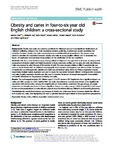Obesity and caries in four-to-six year old English children: a cross-sectional study
| dc.contributor.author | Paisi, M | |
| dc.contributor.author | Kay, E | |
| dc.contributor.author | Kaimi, I | |
| dc.contributor.author | Witton, R | |
| dc.contributor.author | Nelder, R | |
| dc.contributor.author | Potterton, R | |
| dc.contributor.author | Lapthorne, D | |
| dc.date.accessioned | 2018-03-26T18:33:38Z | |
| dc.date.issued | 2018-12 | |
| dc.identifier.issn | 1471-2458 | |
| dc.identifier.issn | 1471-2458 | |
| dc.identifier.other | 267 | |
| dc.identifier.uri | http://hdl.handle.net/10026.1/11174 | |
| dc.description.abstract |
BACKGROUND: Obesity and caries are common conditions in childhood and can have significant implications on children's wellbeing. Evidence into their association remains conflicting. Furthermore, studies examining the ssociation between obesity and caries commonly focus on individual-level determinants. The present study aimed to examine the association between obesity and caries in young English children and to determine the impact of deprivation and area-level characteristics on the distribution of the two conditions. METHODS: This was a cross-sectional study among children in Plymouth city aged four-to-six years. Anthropometric measurements included weight and height (converted to Body Mass Index centiles and z-scores), and waist circumference. Caries was assessed by using the sum of the number of teeth that were decayed, missing or filled. A questionnaire was used to obtain information on children's demographic characteristics, oral hygiene, and dietary habits. The impact of deprivation on anthropometric variables and caries was determined using Linear and Poisson regression models, respectively. Multiple logistic regression was used to assess the association between different anthropometric measures and caries. Logistic regression models were also used to examine the impact of several demographic characteristics and health behaviours on the presence of obesity and caries. RESULTS: The total sample included 347 children aged 5.10 ± 0.31 (mean ± SD). Deprivation had a significant impact on caries and BMI z-scores (p < 0.05). Neither BMI- nor waist circumference z-scores were shown to be significantly associated with dental caries. Among the neighbourhood characteristics examined, the percentage of people dependent on benefits was found to have a significant impact on caries rates (p < 0.05). Household's total annual income was inversely related to caries risk and parental educational level affected children's tooth brushing frequency. CONCLUSIONS: No associations between any measure of obesity and caries were found. However, deprivation affected both obesity and caries, thus highlighting the need to prioritise disadvantaged children in future prevention programmes. | |
| dc.format.extent | 267- | |
| dc.format.medium | Electronic | |
| dc.language | en | |
| dc.language.iso | eng | |
| dc.publisher | Springer Science and Business Media LLC | |
| dc.subject | Obesity | |
| dc.subject | Caries | |
| dc.subject | Children | |
| dc.subject | Inequalities | |
| dc.subject | Socioeconomic status | |
| dc.title | Obesity and caries in four-to-six year old English children: a cross-sectional study | |
| dc.type | journal-article | |
| dc.type | Article | |
| plymouth.author-url | https://www.ncbi.nlm.nih.gov/pubmed/29454320 | |
| plymouth.issue | 1 | |
| plymouth.volume | 18 | |
| plymouth.publication-status | Published | |
| plymouth.journal | BMC Public Health | |
| dc.identifier.doi | 10.1186/s12889-018-5156-8 | |
| plymouth.organisational-group | /Plymouth | |
| plymouth.organisational-group | /Plymouth/Faculty of Health | |
| plymouth.organisational-group | /Plymouth/Faculty of Health/Peninsula Dental School | |
| plymouth.organisational-group | /Plymouth/Faculty of Health/School of Nursing and Midwifery | |
| plymouth.organisational-group | /Plymouth/REF 2021 Researchers by UoA | |
| plymouth.organisational-group | /Plymouth/REF 2021 Researchers by UoA/UoA03 Allied Health Professions, Dentistry, Nursing and Pharmacy | |
| plymouth.organisational-group | /Plymouth/Research Groups | |
| plymouth.organisational-group | /Plymouth/Research Groups/Institute of Health and Community | |
| plymouth.organisational-group | /Plymouth/Research Groups/Institute of Translational and Stratified Medicine (ITSMED) | |
| plymouth.organisational-group | /Plymouth/Research Groups/Institute of Translational and Stratified Medicine (ITSMED)/CCT&PS | |
| plymouth.organisational-group | /Plymouth/Users by role | |
| plymouth.organisational-group | /Plymouth/Users by role/Academics | |
| dc.publisher.place | England | |
| dcterms.dateAccepted | 2018-02-06 | |
| dc.identifier.eissn | 1471-2458 | |
| dc.rights.embargoperiod | Not known | |
| rioxxterms.versionofrecord | 10.1186/s12889-018-5156-8 | |
| rioxxterms.licenseref.uri | http://www.rioxx.net/licenses/all-rights-reserved | |
| rioxxterms.licenseref.startdate | 2018-02-17 | |
| rioxxterms.type | Journal Article/Review |


